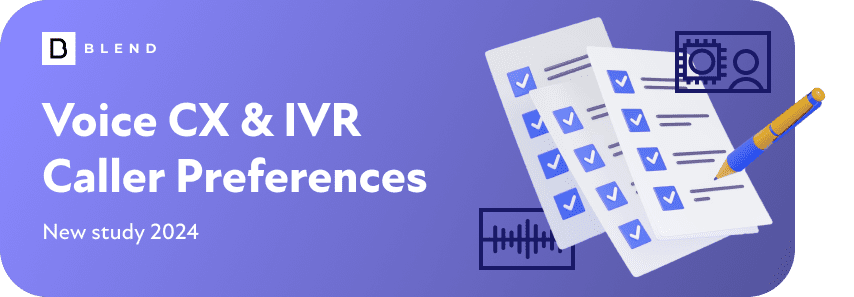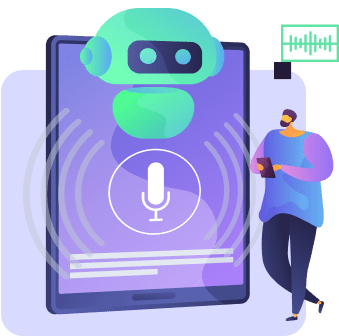
New Study: 2024 BLEND Voice CX Caller Preferences
The customer experience has evolved. Contact channels like web chat and social media have given consumers more control over how they engage with brands, receive customer service, and make buying decisions. But with all this change, where does the voice channel, the notorious telephone, stand with customers?
BLEND conducted an online survey to get a pulse on people’s perceptions of the modern-day IVR/voice CX experience, receiving responses from all age demographics on every continent. The results were a bit surprising, demonstrating that the voice channel—automated technologies and prerecorded voice prompts—is resilient, still relied on heavily (particularly for same-day assistance), and consistent in providing “good” customer interactions across the board.

Survey Highlights:
- 68.7% of respondents interact with IVR systems at least a few times per month
- 55.6% have the most success with the telephone for ‘immediate’ or same-day resolution
- 78.5% say the technical audio quality of voice prompts and on-hold music are “very important” or “important”
- 60.3% believe they could accurately distinguish between a ‘human’ and AI voice on an IVR interaction
- 52.3% would prefer a human voice to greet and guide them through phone menus
Even with omnichannel, the phone is still omnipresent.
With wide-reaching corporate applications covering bills, personal banking, and customer service, most people interact with automated phone systems frequently.

When the matter is urgent, the phone is the choice for getting things done.
A clear majority relies on the voice channel when a customer service necessitates fast resolution.
Crunching the data, age breakdowns were particularly interesting to us, especially the opinions of younger people. For most questions, their responses were consistent with other age demos, varying only a percentage point or two. However, we noted this question as an outlier, where 61.4% of respondents aged 34 or younger chose the phone as the fastest contact channel.
OK Computer – most callers feel good about their experiences.
Turning the customer experience over to automation has long been regarded as a point of frustration for callers, but our findings indicate that the tide has turned and these interactions are typically good, and clearly not bad. 53% described their general experiences as “positive” or “very positive.”

Clarity in scripting & UI is key.
Streamlined, concise menu prompts that accurately and comprehensively route calls are essential to a satisfactory caller experience.
High fidelity for higher caller satisfaction.
Findings also reaffirm that clean, clear audio with consistent volume reduces error inputs, hastens resolutions, and improves the caller experience.

Say it for the people in the back – voice matters.
With clear enunciation, proper inflection, and a natural, brand-authentic persona, callers are more likely to respond favorably to high-quality voice prompts on the phone.
More human than human? Maybe not just yet.
A clear majority of callers (60%) believe they can properly discern a human vs. AI voice. But is the general public aware of recent AI advancements?
AI voices have come a long way in a short period. We believe that the old perception of text-to-speech ‘robot’ voices may have influenced our data, and that many callers may not be aware of how lifelike AI recordings have gotten, and how they can be used almost interchangeably with human recordings.

Power to the people – callers prefer human voice.
Most people state their preference for human voice recordings on automated caller interactions.
A multi-voice CX isn’t significant to a plurality (but bothers many).
A single IVR engagement may feature multiple voices when calls are routed to different departments or when menu prompts are re-recorded and replaced over time. More than half are unbothered, but nearly 40% don’t like it.

Female voices edge out male voices, but most don’t have a preference.
Research has pointed to history and biology for a preference for female voices in the contact center space, and inasmuch as there is a preference, our findings also bear that out. But most respondents didn’t specify a gender preference.
This was somewhat surprising to us. When BLEND compiles end-of-year recording data, female voices always average between 75% and 82% for all IVR projects. While female voices have an edge on male voices, a plurality had no preference. Perhaps it’s time for us to less assumptive and position more male voices for specific project auditions!
To Sum It Up
It was surprising to learn how enduring the telephone is, both for its general frequency of use and its importance for critical customer service issues. Especially given the average age of our respondents, who might be assumed to rely more heavily on other contact channels.

The survey limited itself to UI and audio questions about CX, never touching on the quality of live agent assistance or even the functionality and scope of the voice applications. We were pleased to learn that UI and voice performance elements are valued highly by callers.
Both in research and anecdotally from working closely with organizations and IVR platform integrators over many years, we’ve understood voice automation to be something of a ‘dirty word’ in the 21st century. For budgetary reasons and pure volume, it was considered a necessary evil. In our survey, it seems like the pendulum is shifting and users are responding better to the self-service benefits, routing functions, and practical utility of IVR systems.
About This Study
As a leader in voice-over and localization services for IVR, CX, and voice-first technologies, BLEND wanted an updated snapshot of customer perceptions of the voice channel.
The survey was conducted by BLEND in April 2024 among international consumers of all ages using an email invitation and online survey. A $100 gift card was raffled to one winning participant. The survey ran for three weeks and was closed with 247 tallied responses.
Here’s a breakdown of the survey respondents:
Gender split:
- 54.2% male
- 42.1% female
- 3.8% preferred not to specify
Age ranges from teenage to senior:
- 18-24: 11.7%
- 24-34: 45.3%
- 35-44: 19.6%
- 45-54: 12.1%
- 55-64: 8.9%
- 65+: 3.3%
Press Inquiries
For questions, comments, or press opportunities, contact BLEND at [email protected].
About BLEND’s Localization & Voice Recording Services for IVR

BLEND is a leading provider of language and voice services for IVR, CX, and voice technology platforms. Offering more than 25,000 linguists and voice actors around the globe, BLEND helps companies humanize their voice applications in 120 languages so they achieve a faster ROI on their technology investment, improve their caller engagements, and deliver a natively local experience for every market they do business.
From its Atlanta-based studio facility, BLEND records 7.5 million words annually in nearly 6,000 recording sessions, specializing in the creation of brand-authentic personas for voice-first applications. Both ‘human’ and AI voices are offered, and companies are guided to the best solution for their unique use cases, audiences, languages, and budget.
Participating in the pioneering recording sessions for groundbreaking voice applications like Siri, Alexa, and OnStar, BLEND Voice (formerly GM Voices) has played an important role in the development of virtual assistants, voice-assisted technologies, and AI voice.
For voice-over assistance for any technology, media, or application, or to coordinate custom auditions or samples, contact us today.

You may also enjoy








